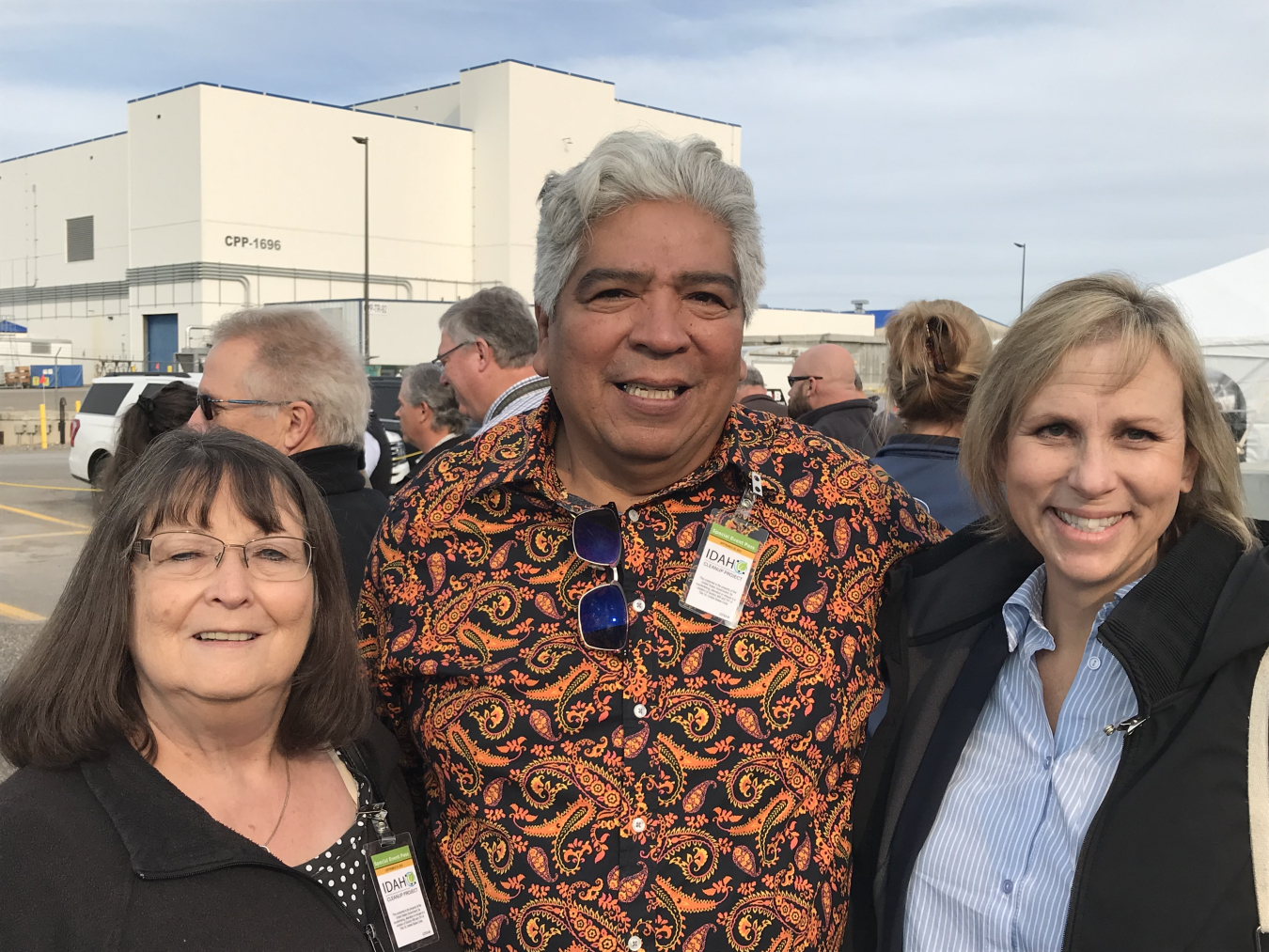The Idaho Environmental Coalition commemorated five months of operations at the Integrated Waste Treatment Unit (IWTU) on Wednesday.
Idaho Cleanup Project Citizens Advisory Board
October 11, 2023By David Pace - Reprinted from the Post Register (9/20/23)

Teri Ehresman, ICP CAB Chair and Two CAB members, Ladd Edmo and Monica Hampton, attended the Integrated Waste Treatment Unit Celebration held at the Idaho National Laboratory Site.
The Idaho Environmental Coalition commemorated five months of operations at the Integrated Waste Treatment Unit (IWTU) on Wednesday.
Gov. Brad Little, U.S. Deputy Secretary of Energy David Turk, Department of Energy’s Office of Environmental Management Senior Adviser William “Ike” White, Idaho Cleanup Project Manager Connie Flohr and Idaho Environmental Coalition President Ty Blackford congratulated more than 100 of the facility’s employees gathered at the event.
"We are here to celebrate a major achievement here on the Idaho Cleanup Project, and that is the final real startup of the IWTU in actually processing sodium-bearing waste," Blackford said.
To date, the Integrated Waste Treatment Unit, which became operational April 11 after years of delays, has treated more than 68,000 gallons of sodium-bearing radioactive liquid waste. This represents 8% of the total 900,000 gallons of liquid waste stored in three underground tanks at the Idaho Nuclear Technology and Engineering Center.
Ladd Edmo, ICP CAB member and a member of the Fort Hall Business Council of the Shoshone-Bannock Tribes, said the opening prayer at the celebration.
“This really is a milestone because this is part of the commitment between the Department (of Energy), the cleanup contractors and the state of Idaho,” Little said. “It really is a testament to the people that have redesigned it, continued to work on it, done it safely and we can see the end in sight. … That’s important that we get this liquid material in those three tanks turned into the safer (granular) form to protect the aquifer of the state of Idaho and to fulfill the commitment.”
Now that the 53,000-square-foot facility is in operation, project leaders anticipate it will take three to seven years to treat all of the liquid waste.
The governor has kept his eye on the project for 12 years as it prepared to commence operations. Construction on the facility began in 2007 and was initially intended to be completed by 2011. According to an Idaho Environmental Coalition release, the unit has since undergone “hundreds of modifications between several demonstration runs with a simulant” to safely prepare the facility to handle the liquid waste.
“It always amazes me when I get a briefing about IWTU about the creativity of the engineers that have modified it, remodified it and remodified it,” Little said. “... I’ve had conversations with everybody from the Secretary (of Energy) down about what we need to do, but the commitment and the resolve of the three different contractors that have been here and most importantly, you that have been working is not to be disputed, and it is to be congratulated.”
Integrated Waste Treatment Unit (IWTU) Operator Russell O’Brien, left, welcomes Deputy Energy Secretary David Turk and EM Senior Advisor William “Ike” White, far right, into the facility's control room prior to a celebratory event marking the successful start and routine operations of IWTU.
The one-of-a-kind unit employs “steam-reforming technology, a process that involves injecting liquid waste into a super-heated vessel containing billions of tiny beads to effectively dry it out,” an Idaho Environmental Coalition fact sheet said.
The waste is transformed into a granular solid that is placed in approximately 10-foot by two-foot stainless steel canisters. These containers are stored on site in concrete vaults in a nearby waste storage facility. Each vault holds 16 canisters.
The Integrated Waste Treatment Unit has 300 employees and operates 24/7 with three shifts.
The project has been the Idaho Cleanup Project's number one priority for years, Flohr said.
"The Settlement Agreement requires us to have produced a certain amount of canisters through the facility here in order for the laboratory to be actually able to bring in research quantities of fuel," she said. "So the lab was actually starting to get to a place where their mission was going to be impacted if we didn't get this facility up and running. Not only are we doing the right thing for the people of Idaho, but we're doing the right thing for the laboratory as well to enable their mission."
So far, more than $1 billion has been invested in the project. The facility costs approximately $100 million annually to operate, said Bill Kirby, Idaho Environmental Coalition senior director of liquid waste and fuels.
A view of the guests at the Integrated Waste Treatment Unit celebration held at the Idaho National Laboratory Site.
Since it first began construction in 2007, the project has been overseen by three contractors — CWI, Fluor and the Idaho Environmental Coalition. Currently, the unit is offline for several months as it undergoes expected maintenance.
Turk recognized the perseverance, problem solving abilities and the public service of the employees who run the facility.
“It’s about doing what’s right by the community (where) we are so fortunate to be hosted here in Idaho Falls and in Idaho,” Turk said. “It’s making sure that (with) the history and the legacy of WWII, the legacy of the Manhattan Project and the legacy of the Cold War, that we are doing right by the cleanup that we as a federal government, we as a population that has benefited from these programs for years and years, do right by the community in which it is located.”
The governor also highlighted the Idaho Environmental Coalition's progress toward fulfilling a key 1995 Settlement Agreement milestone.
“I’m excited to come back when we fill the last cask,” Little said. “I may not be governor then, but I’ll come back.”

